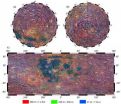(Press-News.org) Two proteins that are abnormally modified in the brains of patients with Alzheimer disease collude, resulting in ill effects on the crucial energy centers of brain cells, according to new findings published online in Neurobiology of Aging.
The research raises the possibility that pathological forms of two proteins, amyloid beta and tau, which make up the pathological hallmarks of the brains of Alzheimer patients – plaques and tangles – may work in tandem to decrease the survival of brain cells.
The findings come as part of a bundle of results from several laboratories that are putting cellular components known as mitochondria under increasing scrutiny in the development of a range of brain conditions, including Alzheimer, Huntington and Parkinson diseases.
Mitochondria are like tiny little energy plants inside neurons and other cells, constantly on the move, churning out the energy that cells need to survive. Mitochondria are also master controllers as they perform additional jobs such as keeping calcium levels normal. A cell with damaged mitochondria is unable to produce sufficient energy to keep the cell going, cannot buffer calcium correctly, and releases oxidative molecules that damage the cell. These types of events may be occurring in the Alzheimer disease brain, resulting in nerve cells that don't function properly.
"The idea that amyloid beta and tau may work together to cause mischief in the brain has been an evolving theme among scientists for a number of years," said Gail Johnson, Ph.D., professor of Anesthesiology and the corresponding author of the paper. "The precise relationship between the two pathologies is unclear, but there may be a synergy between the two when it comes to their effects on mitochondria in Alzheimer disease."
Johnson's group took a particularly close look at a pathological form of the protein known as tau, which helps stabilize a network of highway-like tracks called microtubules in neurons. In recent years scientists like Johnson have been focusing on an abnormally shortened form of the protein, known as truncated tau, as one that likely has a role in Alzheimer disease.
Johnson's team looked at the performance of mitochondria in rat neurons during exposure to amyloid beta, to the regular tau protein, to the truncated version of tau, and to combinations of amyloid beta and the two versions of tau. Among the experiments was one in which scientists tracked the movement of mitochondria, snapping a new image every 10 seconds during a five-minute span to track the movements of the organelles within neurons.
The biggest changes to mitochondria occurred when amyloid beta and truncated tau were present together. Effects included:
The ability of mitochondria to maintain their electrical potential, which is needed to produce energy efficiently, was severely impaired. They had only one-third of the electrical potential of mitochondria in control cells.
Mitochondria usually are highly mobile and distributed throughout the cell. However, in the presence of truncated tau and amyloid beta, mitochondria clumped together abnormally in some parts of neurons and failed to get to other parts of neurons, such as the synapses, like they normally do. Overall, only about half the mitochondria were mobile compared to their counterparts not exposed to the pathological proteins.
Cells that were exposed to both truncated tau and amyloid beta were less able than usual to respond to cellular stress. The number of harmful molecules known as reactive oxygen species or free radicals was boosted 60 percent in these cells.
Mitochondria exposed to amyloid beta and truncated tau were fragmented, with the average length just half that of normal mitochondria.
The cellular changes that Johnson is looking at likely occur before a patient begins to experience symptoms like memory loss. Most scientists believe that changes in the brains of Alzheimer patients begin years or even decades before the signs of Alzheimer disease become apparent.
"By the time the cells are dead, it's far too late to do much," said Johnson, who is also a professor in the Department of Pharmacology and Physiology and a scientist in the Center for Neural Development and Disease. "Therefore, in the field of Alzheimer research, investigators are looking for early markers and indicators of disease so that patients could be identified before significant nerve cell death has occurred. In addition, studies in many labs are ongoing to identify treatments that could target these early events.
"Perhaps," Johnson adds, "the new information on mitochondrial dysfunction in Alzheimer disease can be used to fight the disease, as it is likely an important target for therapeutic intervention. Given the fact that Alzheimer disease is a very complex disease, a monotherapeutic approach may not be as effective as a combinatorial treatment strategy, as is the case for treating other diseases including cancer and diabetes. Further studies on why and how mitochondria are compromised in Alzheimer disease as well as other neurodegenerative conditions are needed to develop effective treatments which will increase mitochondrial function and improve the health of the brain cells."
###
Other authors of the paper include post-doctoral associate Rodrigo Quintanilla, Ph.D., who is first author of the paper; Philip Dolan, Ph.D., now at Neotope Biosciences, a division of Elan Pharmaceuticals; and Youngman Jin, Ph.D., now at Harvard. The work was funded by the Alzheimer's Assn. and the National Institute of Neurological Disorders and Stroke.
2 defective proteins conspire to impair the nerve cell's 'powerhouse' in Alzheimer's disease
2011-05-14
ELSE PRESS RELEASES FROM THIS DATE:
MIT research: Toward faster transistors
2011-05-14
CAMBRIDGE, Mass. -- In the 1980s and '90s, competition in the computer industry was all about "clock speed" — how many megahertz, and ultimately gigahertz, a chip could boast. But clock speeds stalled out almost 10 years ago: Chips that run faster also run hotter, and with existing technology, there seems to be no way to increase clock speed without causing chips to overheat.
In this week's issue of the journal Science, MIT researchers and their colleagues at the University of Augsburg in Germany report the discovery of a new physical phenomenon that could yield transistors ...
The ties that bind: Grandparents and their grandchildren
2011-05-14
Close your eyes for a moment, open your treasure trove of memories and take a step back in time to your childhood. Do you remember your grandfather gently scooping you up into his warm and comforting embrace? Or sitting by your grandmother's side as she lovingly baked pies chock full of delicious, juicy warm apples sprinkled with crumbly cinnamon bits?
The bond between grandparents and their grandchildren seems to be a magical one, and now, a new article published in the April issue of Current Directions in Psychological Science, a journal of the Association for Psychological ...
Scientists design new anti-flu virus proteins using computational methods
2011-05-14
A research article May 12 in Science demonstrates the use of computational methods to design new antiviral proteins not found in nature, but capable of targeting specific surfaces of flu virus molecules.
One goal of such protein design would be to block molecular mechanisms involved in cell invasion and virus reproduction.
Computationally designed, surface targeting, antiviral proteins might also have diagnostic and therapeutic potential in identifying and fighting viral infections.
The lead authors of the study are Sarel J. Fleishman and Timothy Whitehead of ...
I know you, bad guy!
2011-05-14
Most people who have had the experience of having pet animals in their houses have the gut feeling that the animals can "recognize" us. They seem to recognize our faces, our voices and our smell. One way or another, they respond to us differently from other people.
Actually, this is not just a gut feeling. Numerous studies have shown that domesticated animals, such as honey bees, chickens, pigeons, sheep, dogs, llamas, penguins, seals, rabbits, horses, lizards and octopuses, can recognize humans individually. The common thing among these animals is that they are exposed ...
Moon's rough 'wrinkles' reveal clues to its past
2011-05-14
Written on the moon's weary face are the damages it has endured for the past 4-1/2 billion years. From impact craters to the dark plains of maria left behind by volcanic eruptions, the scars are all that remain to tell the tale of what happened to the moon. But they only hint at the processes that once acted—and act today—to shape the surface.
To get more insight into those processes, Meg Rosenburg and her colleagues at the California Institute of Technology, Pasadena, Calif. put together the first comprehensive set of maps revealing the slopes and roughness of the moon's ...
Satellite images display extreme Mississippi River flooding from space
2011-05-14
Recent Landsat satellite data captured by the USGS and NASA on May 10 shows the major flooding of the Mississippi River around Memphis, Tenn. and along the state borders of Tennessee, Kentucky, Missouri, and Arkansas as seen from 438 miles above the Earth.
The flood crest of 47.87 feet on May 10, is the second highest rise in recent history; the highest being 48.7 feet in 1937. Five counties surrounding Memphis have been declared disaster areas, and the costs of the flooding are expected to approach $1 billion. The Mississippi River crest continues to move south and ...
Imajin Books Releases 'Under a Texas Star', a Historical Western Romance by Alison Bruce
2011-05-14
Imajin Books is pleased to announce the release of Under a Texas Star, a historical western romance by Alison Bruce that is already receiving rave reviews. Midwest Book Review calls it, "A delightful Western tale that blends engaging adventure with spirited romance. Reminds me of Louis L'Amour novels." Award-winning author Phyllis Smallman says, "This is a rollicking adventure and Marly Landers is a girl with True Grit."
So what's Under a Texas Star about?
Disguised as a boy, Marly joins a handsome Texas Ranger in the hunt for a con man and they ...
Rochester autism researchers present new findings at IMFAR
2011-05-14
Much about autism is unknown, but researchers from the University of Rochester Medical Center (URMC) are working to learn more about the neurodevelopmental disorder and its most effective treatments. A team of researchers from URMC joins researchers from across the world in San Diego this week for the 10th annual International Meeting for Autism Research (IMFAR).
Rochester researchers are presenting six abstracts on topics ranging from complementary medicine-use rates to nutritional insufficiencies in children with autism spectrum disorders. They even looked at how artificial ...
Group Buying Platform OfferMe Unveils its Virtual Shopping Centre
2011-05-13
Australian-based Group Buying Platform OfferMe has launched MeStore its virtual shopping centre and aims at a different business model from Groupon.
"Sixty percent of our existing sellers are joining our virtual shopping centre which will gradually carry over 200,000 products, with approximately 50,000 products at launch," said Mr. James Wang, Managing Director of OfferMe.
"We are excited and encouraged by our sellers offering both heavily discounted group buying deals and many other great value products."
Offerme.com.au said sellers open ...
Indie Rock Band Burning Red Sun Releases EP
2011-05-13
Burning Red Sun is trailblazing its way out of the Jersey rock scene and into the US mainstream, and what best way to do it than release an epic EP titled 'Living on the Edge of Time'.
Burning Red Sun is the rock project of founding members Ken Lazorchack, Mike Gomez, and Jim Russo. All three are experienced rockers: Ken is a staple of the New Jersey rock scene, previously a member of renowned bands Laughen Bones and The Lost Highway Ramblers. One of his greatest achievements is having been mentored by the great blues legend Roy Buchanan. Meanwhile in Detroit, Mike Gomez ...



